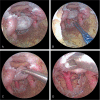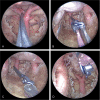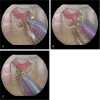Endoscopic Endonasal Transclival Approach versus Dual Transorbital Port Technique for Clip Application to the Posterior Circulation: A Cadaveric Anatomical and Cerebral Circulation Simulation Study
- PMID: 28593110
- PMCID: PMC5461166
- DOI: 10.1055/s-0036-1597278
Endoscopic Endonasal Transclival Approach versus Dual Transorbital Port Technique for Clip Application to the Posterior Circulation: A Cadaveric Anatomical and Cerebral Circulation Simulation Study
Abstract
Purpose Simulation training offers a useful opportunity to appreciate vascular anatomy and develop the technical expertise required to clip intracranial aneurysms of the posterior circulation. Materials and Methods In cadavers, a comparison was made between the endoscopic transclival approach (ETA) alone and a combined multiportal approach using the ETA and a transorbital precaruncular approach (TOPA) to evaluate degrees of freedom, angles of visualization, and ergonomics of aneurysm clip application to the posterior circulation depending on basilar apex position relative to the posterior clinoids. Results ETA alone provided improved access to the posterior circulation when the basilar apex was high riding compared with the posterior clinoids. ETA + TOPA provided a significantly improved functional working area for instruments and visualization of the posterior circulation for a midlevel basilar apex. A single-shaft clip applier provided improved visualization and space for instruments. Proximal and distal vascular control and feasibility of aneurysmal clipping were demonstrated. Conclusions TOPA is a medial orbital approach to the central skull base; a transorbital neuroendoscopic surgery approach. This anatomical simulation provides surgical teams an alternative to the ETA approach alone to address posterior circulation aneurysms, and a means to preoperatively prepare for intraoperative anatomical and surgical instrumentation challenges.
Keywords: endonasal transclival approach; endoscopic approach; posterior circulation aneurysms; simulation training; transorbital neuroendoscopic surgery.
Conflict of interest statement
Figures







Similar articles
-
Dual Endoscopic Endonasal Transsphenoidal and Precaruncular Transorbital Approaches for Clipping of the Cavernous Carotid Artery: A Cadaveric Simulation.J Neurol Surg B Skull Base. 2016 Dec;77(6):485-490. doi: 10.1055/s-0036-1584094. Epub 2016 May 24. J Neurol Surg B Skull Base. 2016. PMID: 27857875 Free PMC article.
-
Endoscopic endonasal clip ligation of cerebral aneurysms: an anatomical feasibility study and future directions.J Neurosurg. 2016 Feb;124(2):463-8. doi: 10.3171/2015.1.JNS142650. Epub 2015 Jul 31. J Neurosurg. 2016. PMID: 26230466
-
Feasibility of endoscopic endonasal approach for clip application of cerebral aneurysms: a systematic review.J Neurosurg Sci. 2018 Dec;62(6):650-657. doi: 10.23736/S0390-5616.18.04405-3. Epub 2018 Mar 26. J Neurosurg Sci. 2018. PMID: 29582975
-
Development of a Cadaveric Multiport Model of Posterior Circulation Aneurysm Clipping for Neurosurgery and Otolaryngology Residents.J Vis Exp. 2021 Sep 3;(175). doi: 10.3791/56809. J Vis Exp. 2021. PMID: 34542529
-
The limits of the endoscopic endonasal transclival approach for posterior fossa tumors.J Neurosurg Sci. 2018 Jun;62(3):322-331. doi: 10.23736/S0390-5616.18.04411-9. Epub 2018 Mar 8. J Neurosurg Sci. 2018. PMID: 29527889 Review.
Cited by
-
Training in Endoscopic Endonasal Neurosurgical Procedures: A Systematic Review of Available Models.J Neurol Surg B Skull Base. 2024 May 23;86(3):278-294. doi: 10.1055/a-2319-0425. eCollection 2025 Jun. J Neurol Surg B Skull Base. 2024. PMID: 40351878 Free PMC article.
-
Simulation training in endoscopic skull base surgery: A scoping review.World J Otorhinolaryngol Head Neck Surg. 2022 Mar 31;8(1):73-81. doi: 10.1002/wjo2.11. eCollection 2022 Mar. World J Otorhinolaryngol Head Neck Surg. 2022. PMID: 35619934 Free PMC article.
-
Transorbital endoscopic approaches to the skull base: a systematic literature review and anatomical description.Neurosurg Rev. 2021 Oct;44(5):2857-2878. doi: 10.1007/s10143-020-01470-5. Epub 2021 Jan 22. Neurosurg Rev. 2021. PMID: 33479806 Free PMC article.
References
-
- Spetzler R F, McDougall C G, Zabramski J M et al. The Barrow Ruptured Aneurysm Trial: 6-year results. J Neurosurg. 2015;123(03):609–617. - PubMed
-
- Lee C H, Chen S M, Lui T N. Posterior cerebral artery pseudoaneurysm, a rare complication of pituitary tumor transsphenoidal surgery: case report and literature review. World Neurosurg. 2015;84(05):14930–1.493E6. - PubMed
-
- Velioglu M, Selcuk H, Kizilkilic O, Basekim C, Kocer N, Islak C. Endovascular management of superior cerebellar artery aneurysms: mid and long-term results. Turk Neurosurg. 2015;25(04):526–531. - PubMed
-
- Petr O, Brinjikji W, Thomé C, Lanzino G. Safety and efficacy of microsurgical treatment of previously coiled aneurysms: a systematic review and meta-analysis. Acta Neurochir (Wien) 2015;157(10):1623–1632. - PubMed
Grants and funding
LinkOut - more resources
Full Text Sources
Other Literature Sources
Miscellaneous

